Possible Mechanisms Contributing to the Occurrence of a Waterspout in Victoria Harbour, Hong Kong, on 28 September 2024: Observational and Numerical Studies
Abstract
1. Introduction
2. Observational Data
3. Numerical Models
4. Results from 200 m WRF
5. Results from 4 m PALM with Buildings
6. Results from 4 m PALM Without Buildings
7. Conclusions
Author Contributions
Funding
Institutional Review Board Statement
Informed Consent Statement
Data Availability Statement
Conflicts of Interest
References
- Choy, C.W.; Tam, H.C.; Chan, Y.W.; He, Y.H.; Chan, P.W.; Lam, C.Y. First Observational Study of a Waterspout at Victoria Harbour, Hong Kong on 28 September 2024. Meteorol. Z. 2025, 33, 445–456. [Google Scholar] [CrossRef]
- Skamarock, W.C.; Klemp, J.B. A Time-Split Nonhydrostatic Atmospheric Model for Weather Research and Forecasting Applications. J. Comput. Phys. 2008, 227, 3465–3485. [Google Scholar] [CrossRef]
- Lo, K.W.; Hon, K.K.; Chan, P.W.; Li, L.; Li, Q.S. Simulation of Building-Induced Airflow Disturbances in Complex Terrain Using Meteorological-CFD Coupled Model. Meteorol. Z. 2022, 31, 317–330. [Google Scholar] [CrossRef]
- Lo, K.-W.; Chan, P.-W.; Lai, K.-K. Observations and Simulations of the Winds at a Bridge in Hong Kong during Two Tropical Cyclone Events in 2023. Appl. Sci. 2024, 14, 7789. [Google Scholar] [CrossRef]
- Simpson, J.; Morton, B.R.; McCumber, M.C.; Penc, R.S. Observations and Mechanisms of GATE Waterspouts. J. Atmos. Sci. 1986, 43, 753–783. [Google Scholar] [CrossRef]
- Hon, K.-K. Predicting Low-Level Wind Shear Using 200-m-Resolution NWP at the Hong Kong International Airport. J. Appl. Meteorol. Climatol. 2020, 59, 193–206. [Google Scholar] [CrossRef]
- Lim, K.-S.S.; Hong, S.-Y. Development of an Effective Double-Moment Cloud Microphysics Scheme with Prognostic Cloud Condensation Nuclei (CCN) for Weather and Climate Models. Mon. Weather Rev. 2010, 138, 1587–1612. [Google Scholar] [CrossRef]
- Iacono, M.J.; Delamere, J.S.; Mlawer, E.J.; Shephard, M.W.; Clough, S.A.; Collins, W.D. Radiative Forcing by Long-lived Greenhouse Gases: Calculations with the AER Radiative Transfer Models. J. Geophys. Res. Atmos. 2008, 113. [Google Scholar] [CrossRef]
- Smagorinsky, J. General Circulation Experiments with the Primitive Equations. I. The Basic Experiment. Mon. Weather Rev. 1963, 91, 99–164. [Google Scholar] [CrossRef]
- Niu, G.-Y.; Yang, Z.-L.; Mitchell, K.E.; Chen, F.; Ek, M.B.; Barlage, M.; Longuevergne, L.; Manning, K.; Niyogi, D.; Tewari, M.; et al. The Community Noah Land Surface Model with Multiparameterization Options (Noah-MP): 2. Evaluation over Global River Basins. J. Geophys. Res. 2011, 116, D12110. [Google Scholar] [CrossRef]
- Raasch, S.; Schröter, M. PALM—A Large-Eddy Simulation Model Performing on Massively Parallel Computers. Meteorol. Z. 2001, 10, 363–372. [Google Scholar] [CrossRef]
- Maronga, B.; Gryschka, M.; Heinze, R.; Hoffmann, F.; Kanani-Sühring, F.; Keck, M.; Ketelsen, K.; Letzel, M.O.; Sühring, M.; Raasch, S. The Parallelized Large-Eddy Simulation Model (PALM) Version 4.0 for Atmospheric and Oceanic Flows: Model Formulation, Recent Developments, and Future Perspectives. Geosci. Model Dev. 2015, 8, 2515–2551. [Google Scholar] [CrossRef]
- Maronga, B.; Banzhaf, S.; Burmeister, C.; Esch, T.; Forkel, R.; Fröhlich, D.; Fuka, V.; Gehrke, K.F.; Geletič, J.; Giersch, S.; et al. Overview of the PALM Model System 6.0. Geosci. Model Dev. 2020, 13, 1335–1372. [Google Scholar] [CrossRef]
- Deardorff, J.W. Stratocumulus-Capped Mixed Layers Derived from a Three-Dimensional Model. Bound. Layer Meteorol. 1980, 18, 495–527. [Google Scholar] [CrossRef]
- Wicker, L.J.; Skamarock, W.C. Time-Splitting Methods for Elastic Models Using Forward Time Schemes. Mon. Weather Rev. 2002, 130, 2088–2097. [Google Scholar] [CrossRef]
- Williamson, J.H. Low-Storage Runge-Kutta Schemes. J. Comput. Phys. 1980, 35, 48–56. [Google Scholar] [CrossRef]
- Xie, Z.-T.; Castro, I.P. Efficient Generation of Inflow Conditions for Large Eddy Simulation of Street-Scale Flows. Flow Turbul. Combust. 2008, 81, 449–470. [Google Scholar] [CrossRef]
- Kim, Y.; Castro, I.P.; Xie, Z.-T. Divergence-Free Turbulence Inflow Conditions for Large-Eddy Simulations with Incompressible Flow Solvers. Comput. Fluids 2013, 84, 56–68. [Google Scholar] [CrossRef]
- Fan, J.; Wang, J.; Lin, Y. Urbanization May Enhance Tornado Potential: A Single Case Report. Front. Earth Sci. 2023, 11, 1148506. [Google Scholar] [CrossRef]
- Lin, Y.; Fan, J.; Jeong, J.-H.; Zhang, Y.; Homeyer, C.R.; Wang, J. Urbanization-Induced Land and Aerosol Impacts on Storm Propagation and Hail Characteristics. J. Atmos. Sci. 2021, 78, 925–947. [Google Scholar] [CrossRef]
- Forster, A.; Augros, C.; Masson, V. Urban Influence on Convective Precipitation in the Paris Region: Hectometric Ensemble Simulations in a Case Study. Q. J. R. Meteorol. Soc. 2024, 150, 3028–3051. [Google Scholar] [CrossRef]
- Du, X.; Sun, T.; Oo, K.T. Spatiotemporal Characteristics of Mesoscale Convective Systems in the Yangtze River Delta Urban Agglomeration and Their Response to Urbanization. Atmosphere 2025, 16, 245. [Google Scholar] [CrossRef]
- Platonov, V.S.; Varentsov, M.I.; Yarinich, Y.I.; Shikhov, A.N.; Chernoulsky, A.V. A Large Mid-Latitude City Intensifies Severe Convective Events: Evidence from Long-Term High-Resolution Simulations. Urban Clim. 2024, 54, 101837. [Google Scholar] [CrossRef]
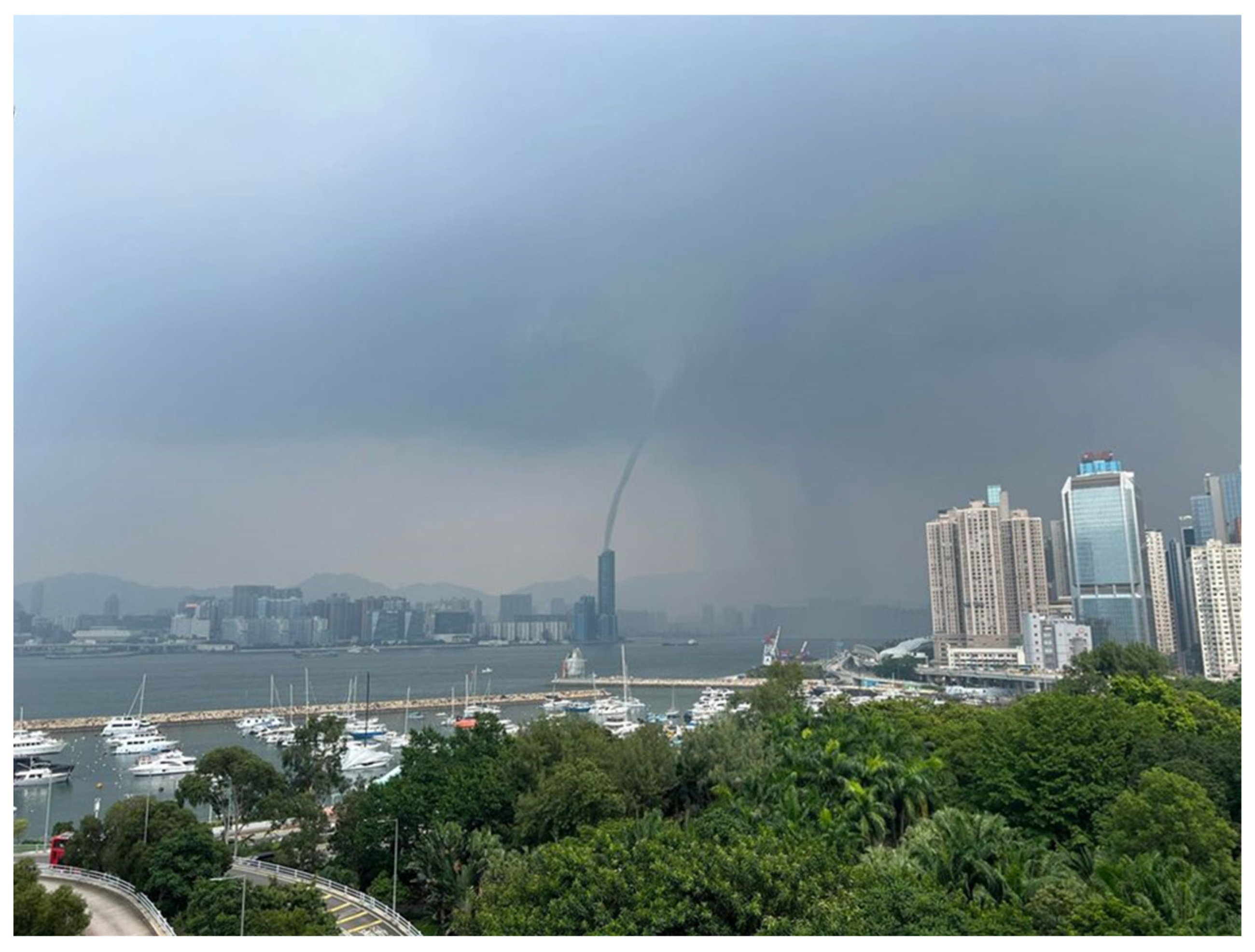


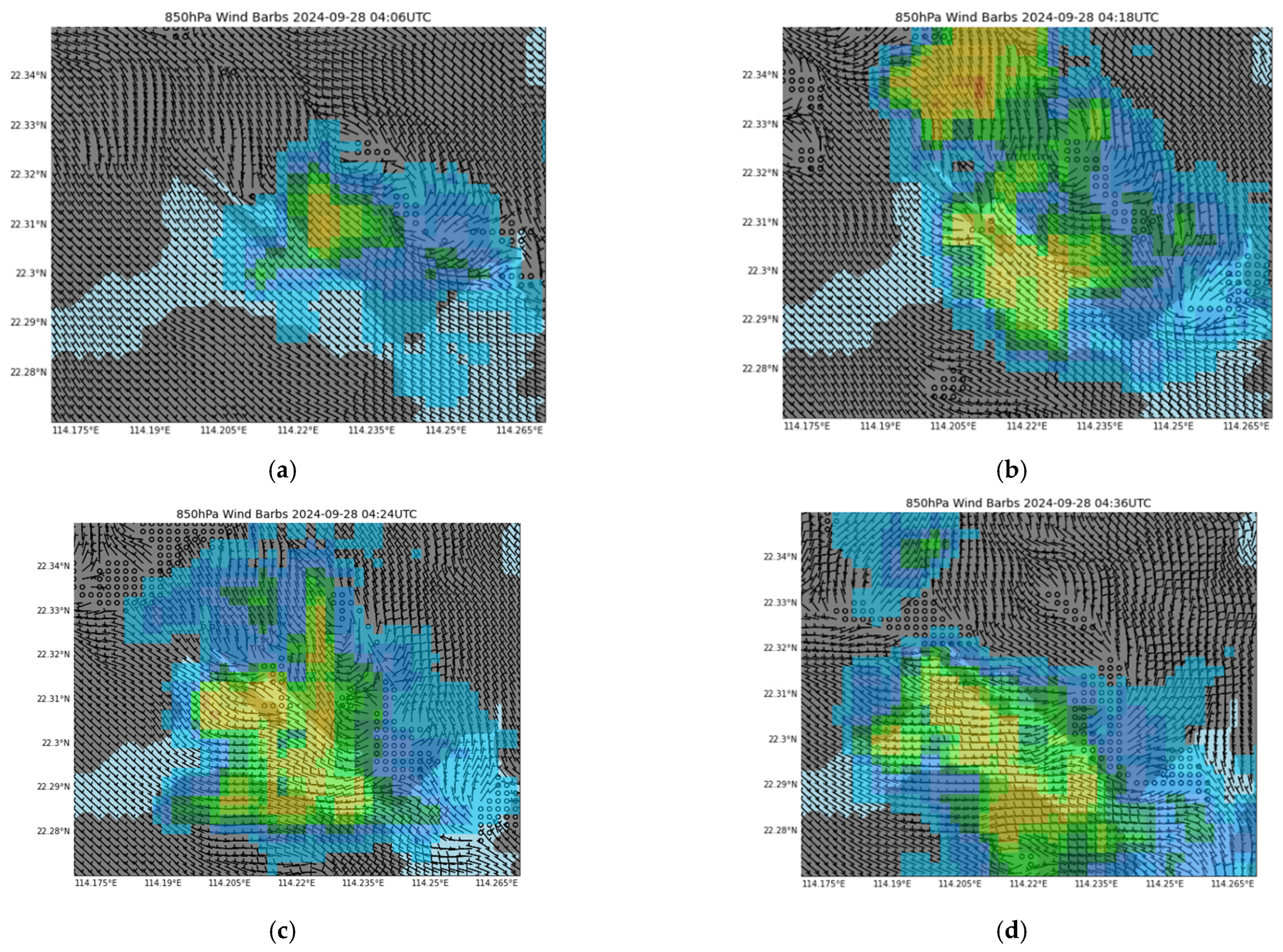

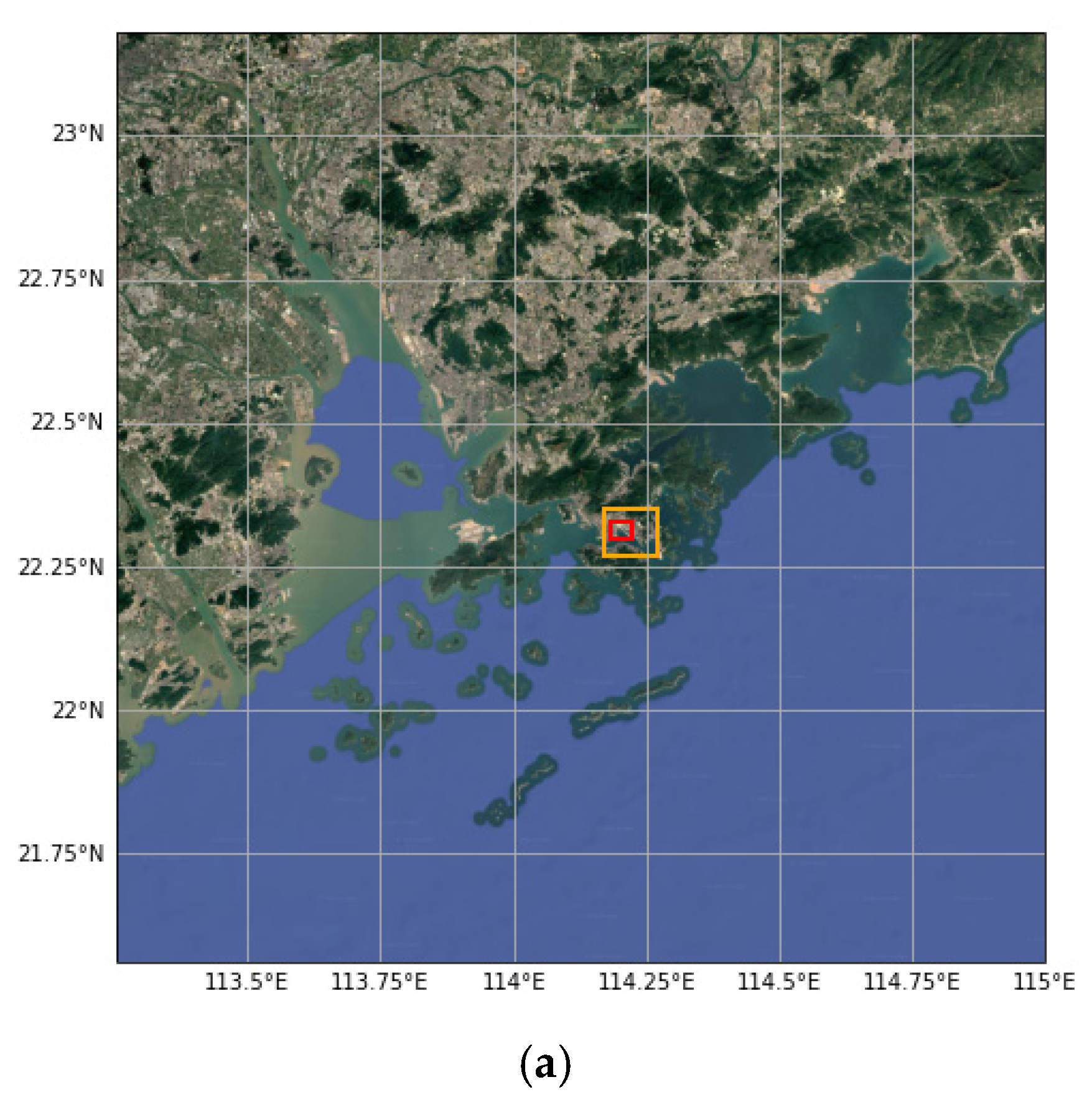
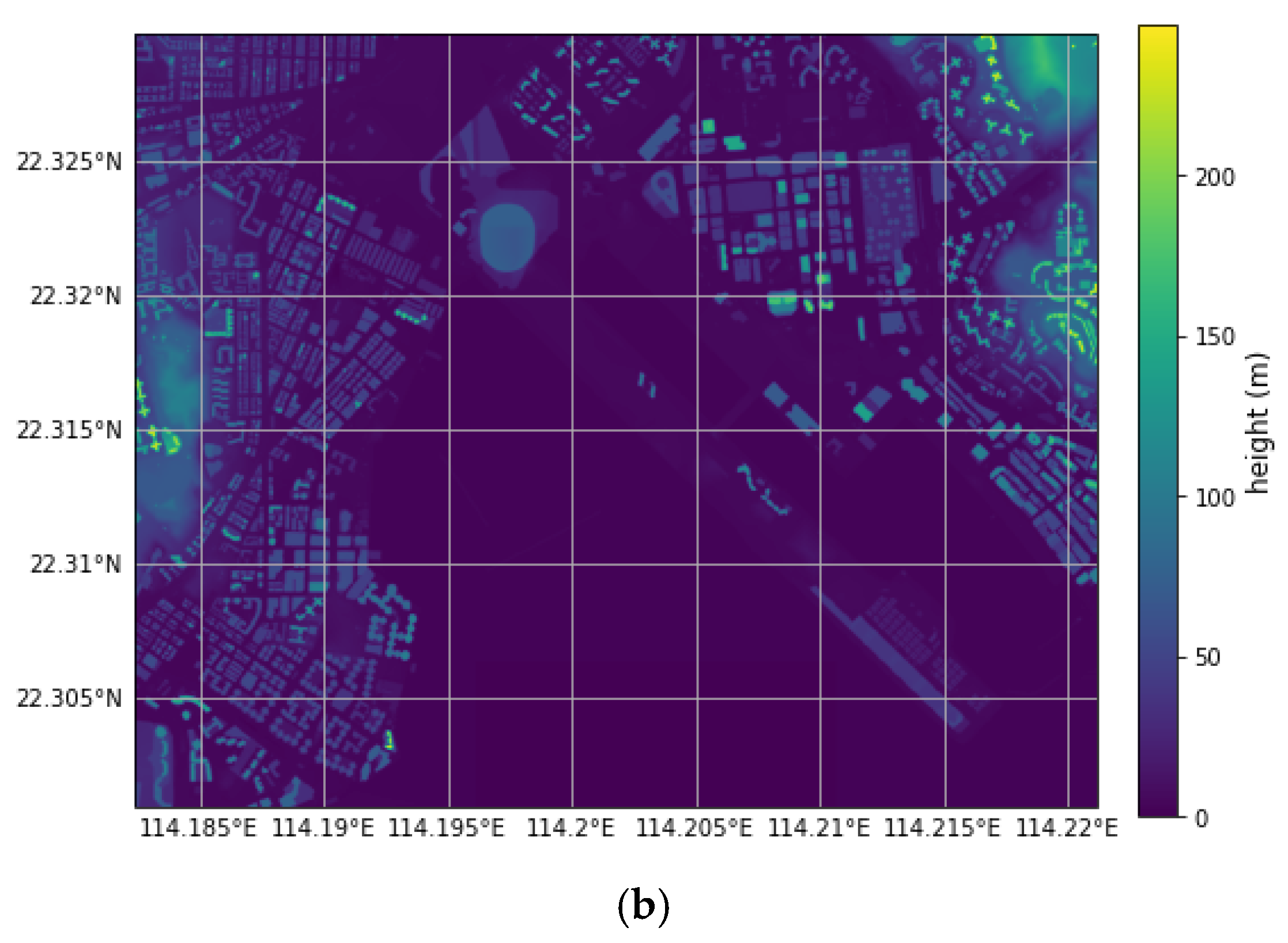



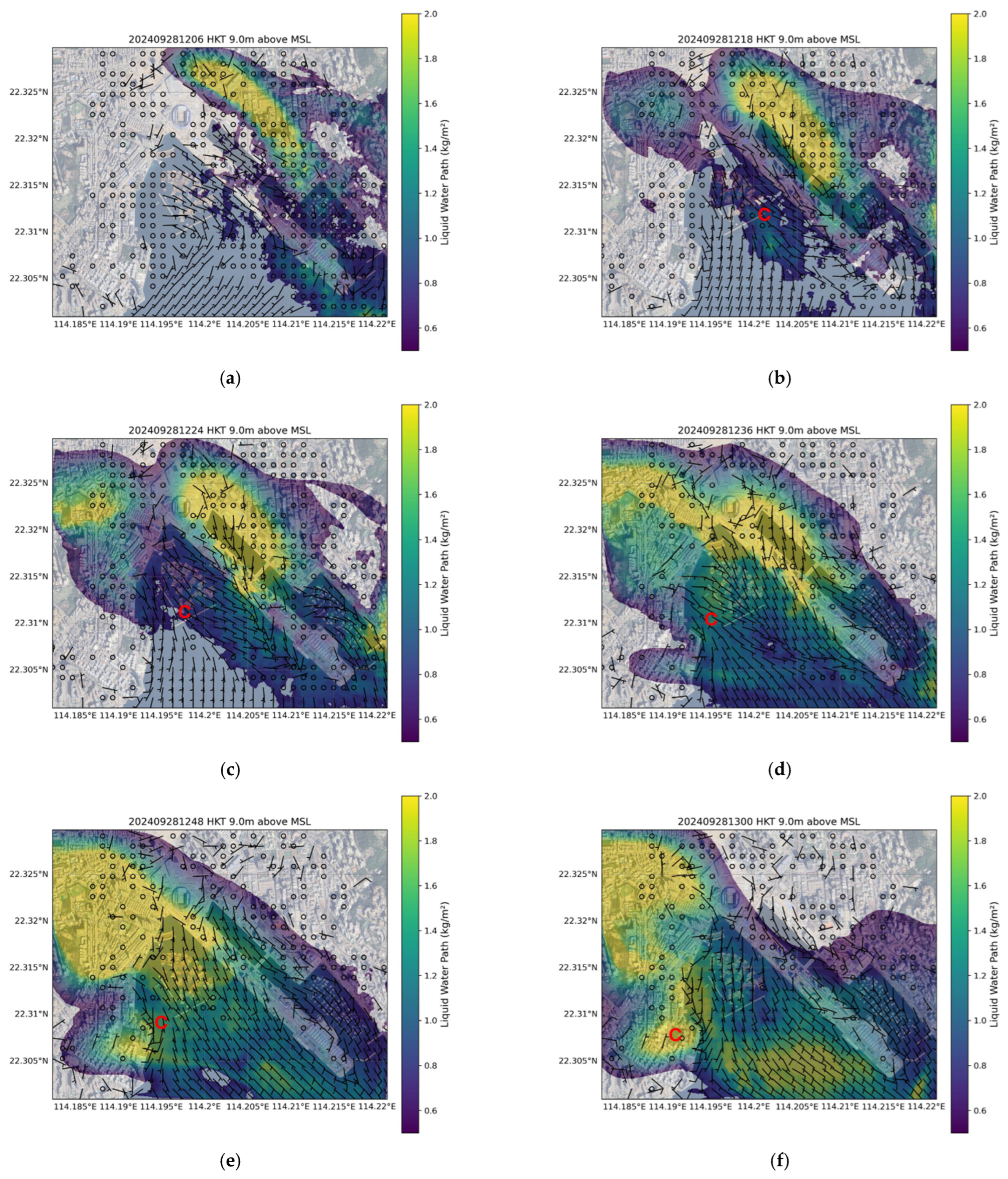

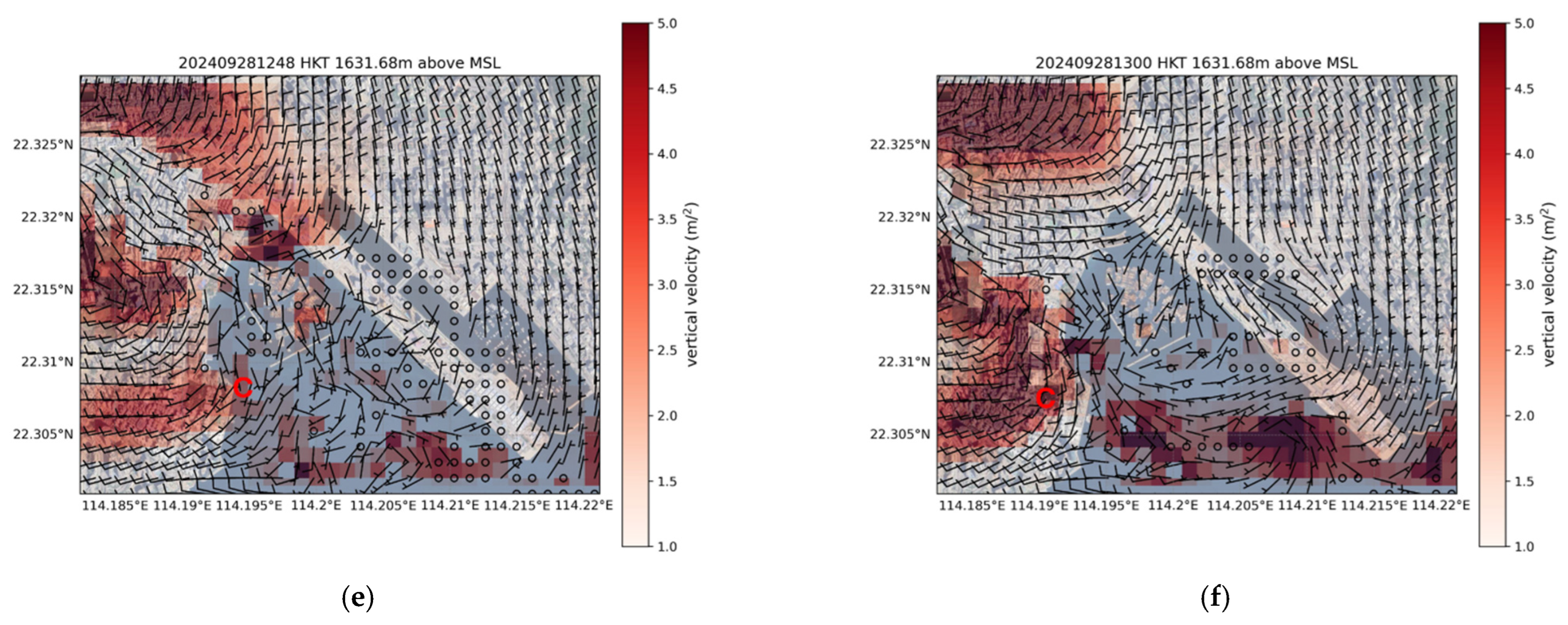
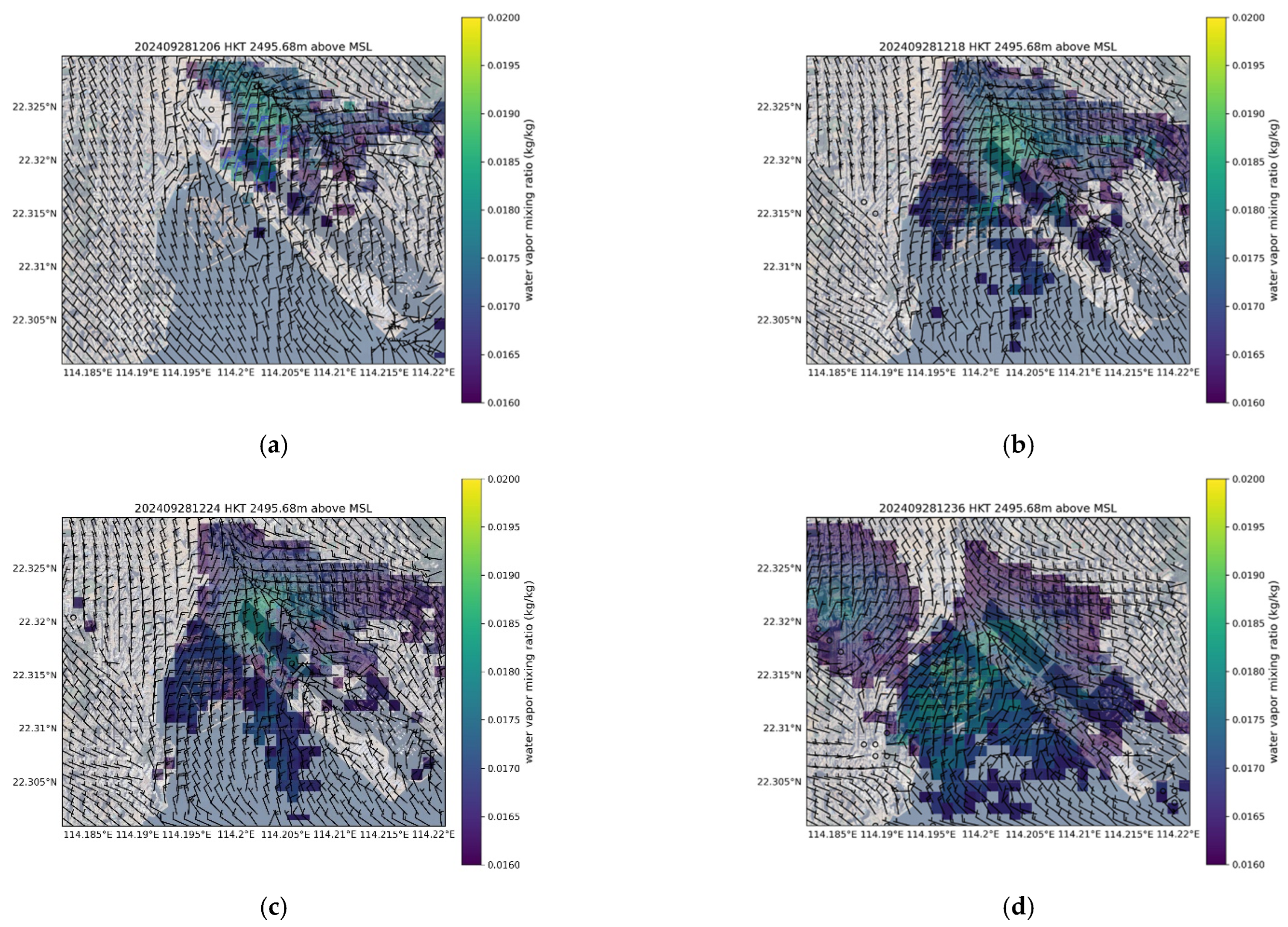
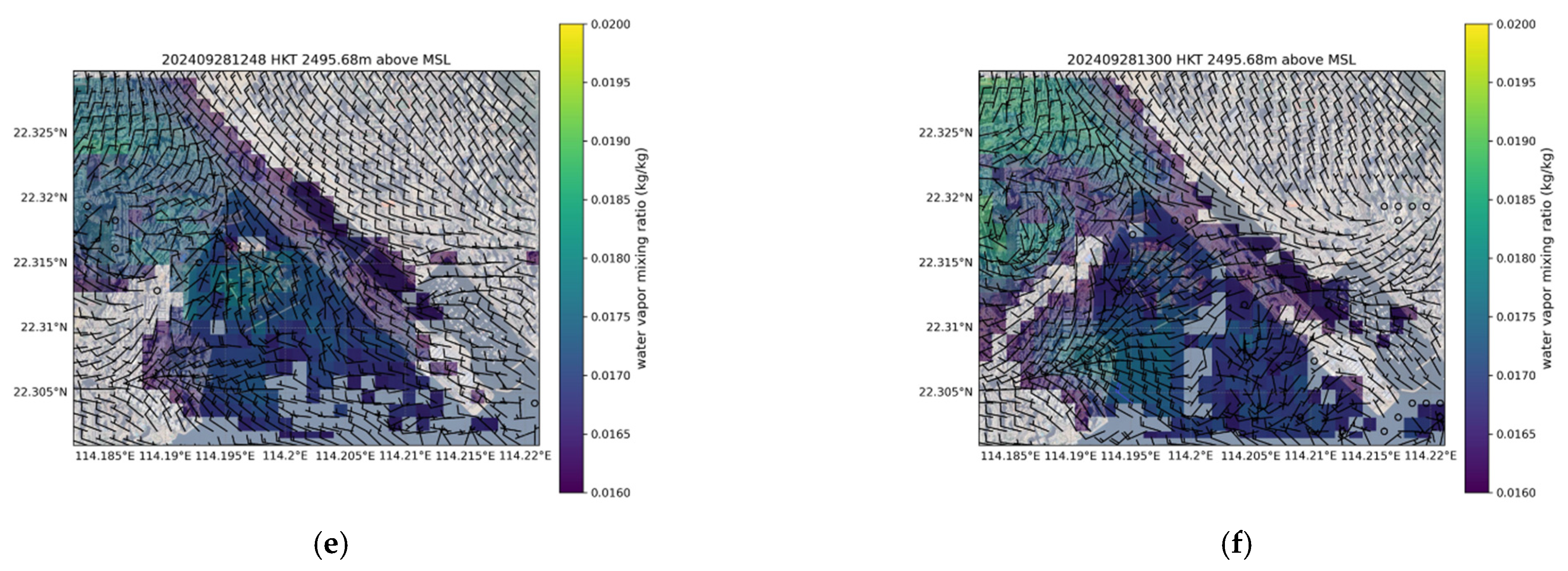
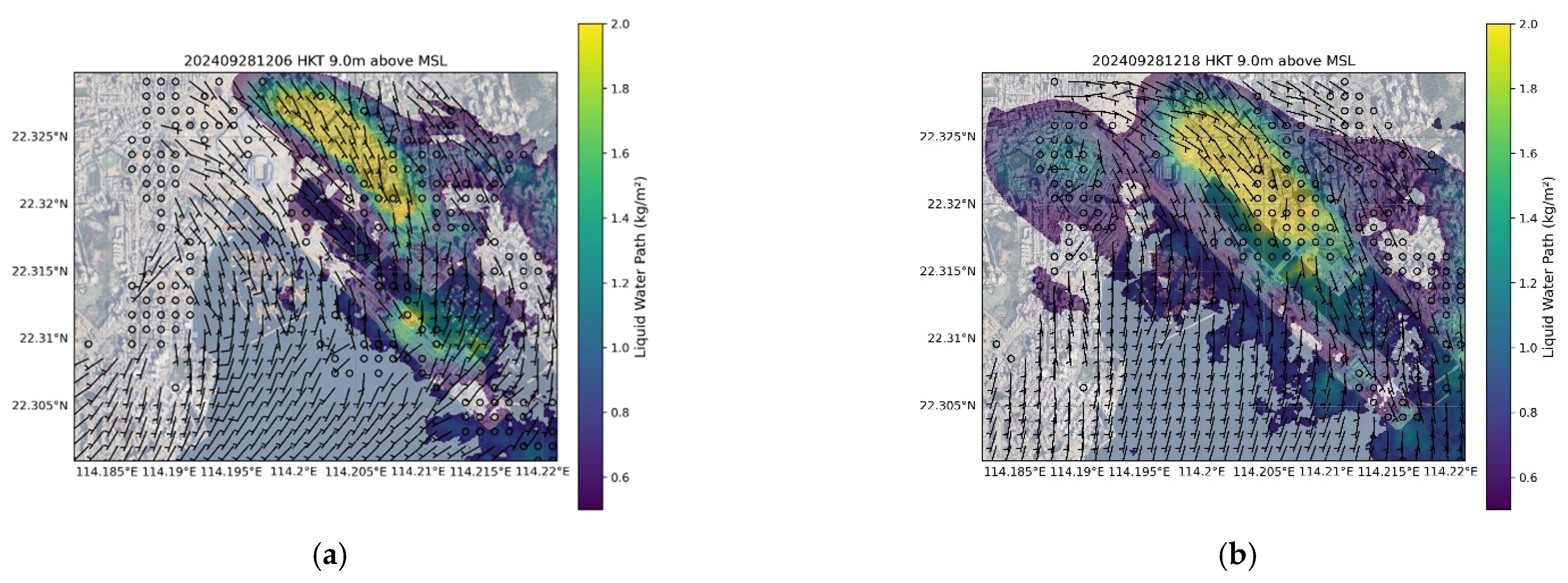
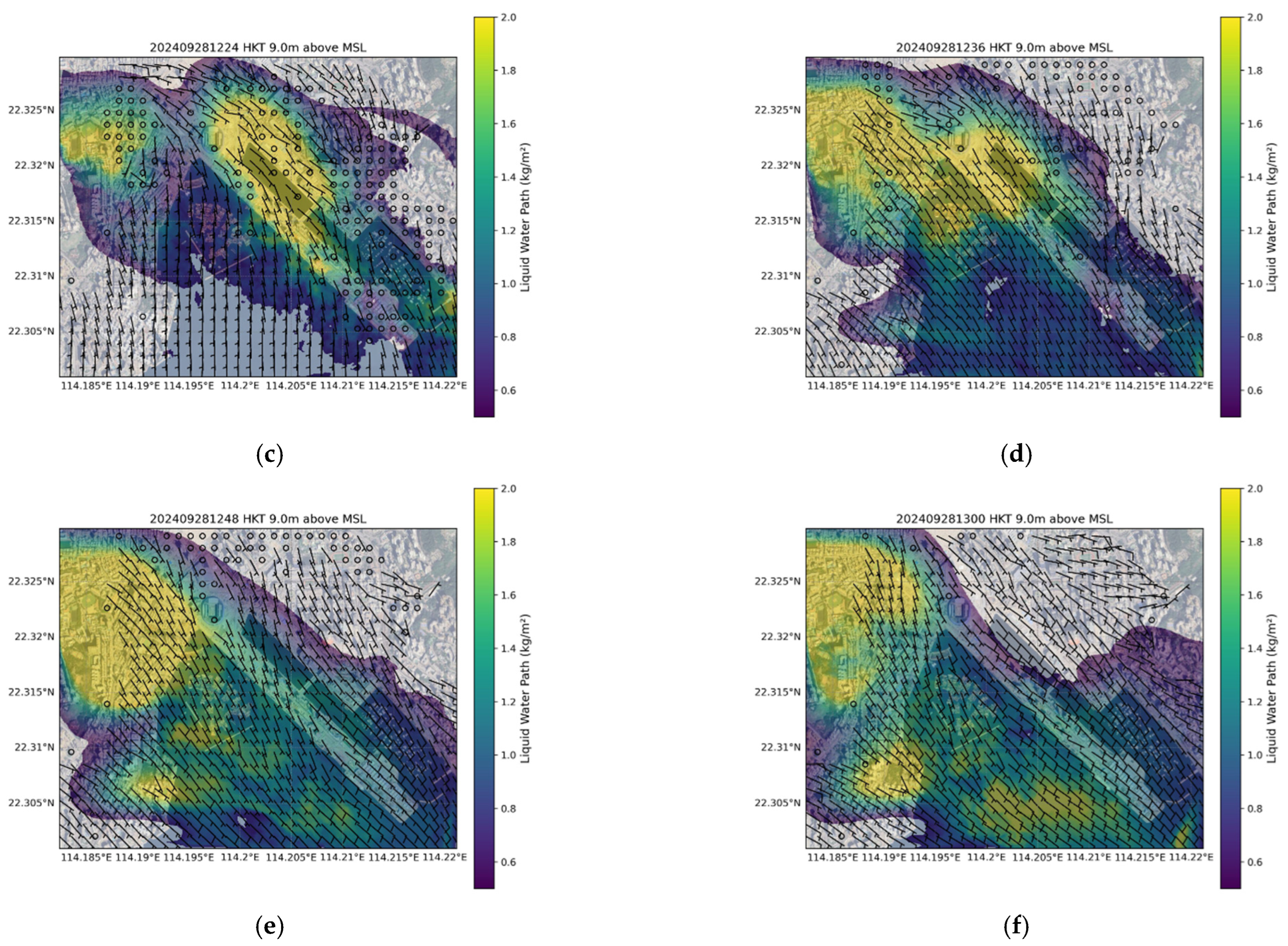
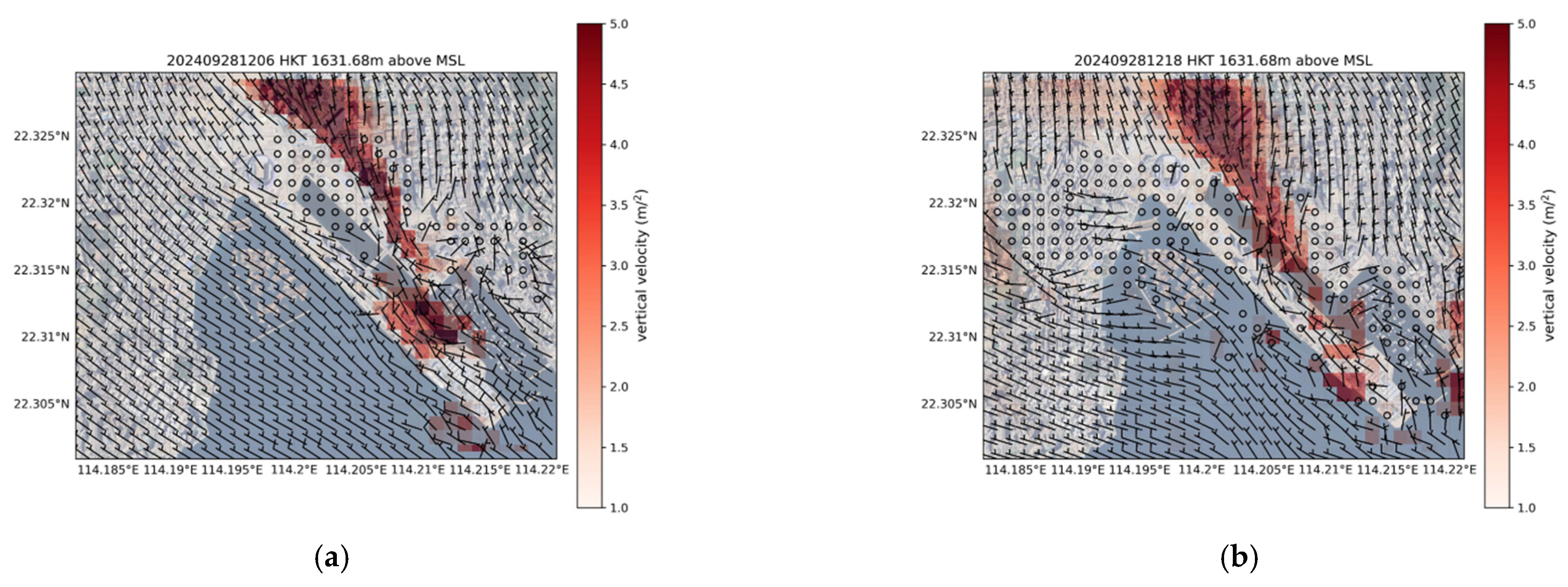
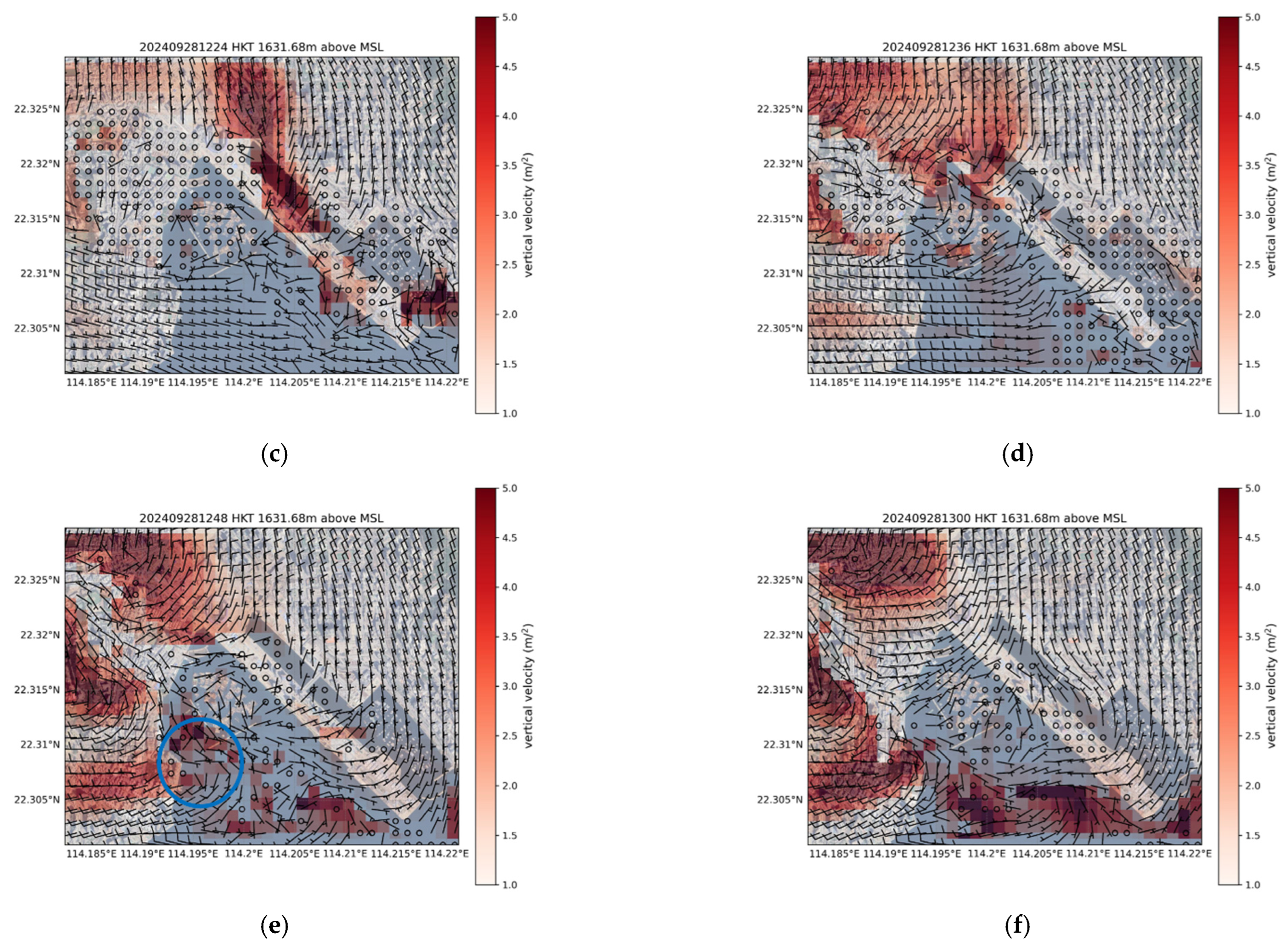
Disclaimer/Publisher’s Note: The statements, opinions and data contained in all publications are solely those of the individual author(s) and contributor(s) and not of MDPI and/or the editor(s). MDPI and/or the editor(s) disclaim responsibility for any injury to people or property resulting from any ideas, methods, instructions or products referred to in the content. |
© 2025 by the authors. Licensee MDPI, Basel, Switzerland. This article is an open access article distributed under the terms and conditions of the Creative Commons Attribution (CC BY) license (https://creativecommons.org/licenses/by/4.0/).
Share and Cite
Chan, P.W.; Lo, K.W.; Lai, K.K. Possible Mechanisms Contributing to the Occurrence of a Waterspout in Victoria Harbour, Hong Kong, on 28 September 2024: Observational and Numerical Studies. Atmosphere 2025, 16, 868. https://doi.org/10.3390/atmos16070868
Chan PW, Lo KW, Lai KK. Possible Mechanisms Contributing to the Occurrence of a Waterspout in Victoria Harbour, Hong Kong, on 28 September 2024: Observational and Numerical Studies. Atmosphere. 2025; 16(7):868. https://doi.org/10.3390/atmos16070868
Chicago/Turabian StyleChan, Pak Wai, Ka Wai Lo, and Kai Kwong Lai. 2025. "Possible Mechanisms Contributing to the Occurrence of a Waterspout in Victoria Harbour, Hong Kong, on 28 September 2024: Observational and Numerical Studies" Atmosphere 16, no. 7: 868. https://doi.org/10.3390/atmos16070868
APA StyleChan, P. W., Lo, K. W., & Lai, K. K. (2025). Possible Mechanisms Contributing to the Occurrence of a Waterspout in Victoria Harbour, Hong Kong, on 28 September 2024: Observational and Numerical Studies. Atmosphere, 16(7), 868. https://doi.org/10.3390/atmos16070868






